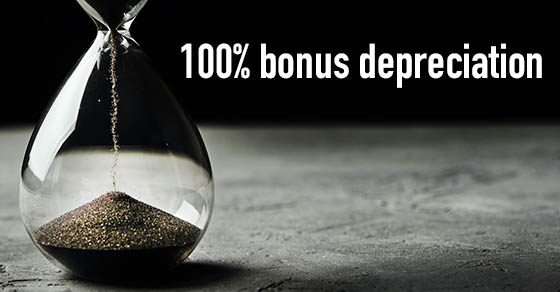Businesses must act now to make the most out of bonus depreciation – part one

There have been different levels of bonus depreciation available for some time. For example, taxpayers could often claim a bonus depreciation deduction for 50% of the purchase price of qualifying property in the first year before adopting the Tax Cuts and Jobs Act (TCJA). The alternative would be deducting lesser amounts over the course of the property’s useful life under the modified accelerated cost recovery system (MACRS).
The potential value of bonus depreciation for taxpayers rose significantly with the TCJA, but only for a brief time. After 2022, the percentage of first-year depreciation that can claim a “bonus” will decline from 100%. Therefore, businesses should make necessary preparations.
The TCJA rose the deduction to 100% in the year that eligible property is technically in service through 2022. After that, the deduction amount will decrease by 20% a year until bonus depreciation expires in 2027. However, Congress could take action to extend it. Longer recovery periods for property are subject to different rules.
The bonus depreciation deduction
Businesses can benefit from the deduction by, among other things, investing in real estate with a 20-year or shorter useful life. This includes computer hardware, software, some vehicles, tools, and office furnishings. Both brand-new and second-hand property are acceptable. In general, used property is eligible if it wasn’t:
- Previously owned by the taxpayer or a predecessor
- Purchased from a connected party
- Acquired through a tax-free exchange
Bonus depreciation also applies to qualified improvement property. Typically, that includes interior renovations to nonresidential property except for:
- Elevators
- Escalators
- Interior structural framework
- Building extension
Although the TCJA’s drafting error made it appear otherwise, the CARES Act made such property eligible for bonus depreciation going back in time. Under certain limitations, taxpayers who put qualified improvement property into operation in 2018, 2019, or 2020 may usually now claim any relevant deductions not claimed then.
Buildings don’t qualify for bonus depreciation because they have a useful life of 27.5 (residential buildings) or 39 (commercial buildings). However, cost segregation studies can show businesses which parts might. These investigations pinpoint real estate components that are movable personal property. Such property qualifies for bonus depreciation in the year it is put into service since it has shorter depreciation recovery periods.
Make the most out of it
The placed-in-service condition is very important for individuals who want to take advantage of 100% bonus depreciation before the maximum deduction amount drops to 80% in 2023. Taxpayers should place their purchases as soon as possible. Especially given the ongoing shipping delays and shortages of labor, materials, and supplies. That would enhance the likelihood that they will be able to use qualifying property in their enterprises before the end of the year.
Keep in mind that unless a taxpayer chooses to opt-out, bonus depreciation is automatically applied by the IRS. All qualifying property in the same class that is put into operation during the same tax year is subject to elections. For example, all five-year MACRS property.
Remember to check back in for the next blog post in this two-part series. We’ll discuss bonus depreciation vs. Section 179 expensing and some caveats there. Contact our RRBB accountants and advisors if you have any questions or need assistance.
© 2022
RRBB eNEWSLETTER
Get free tax planning and financial advice




